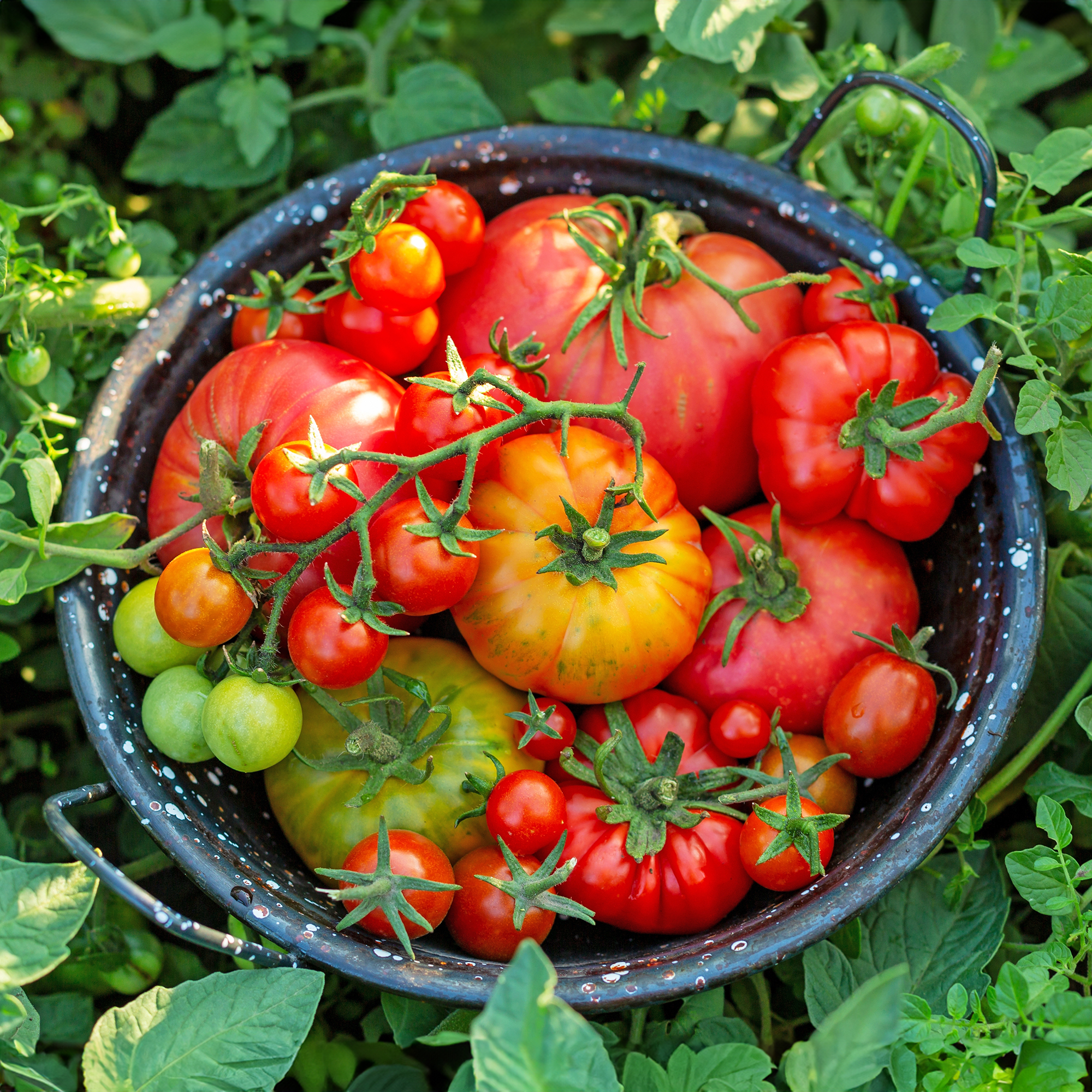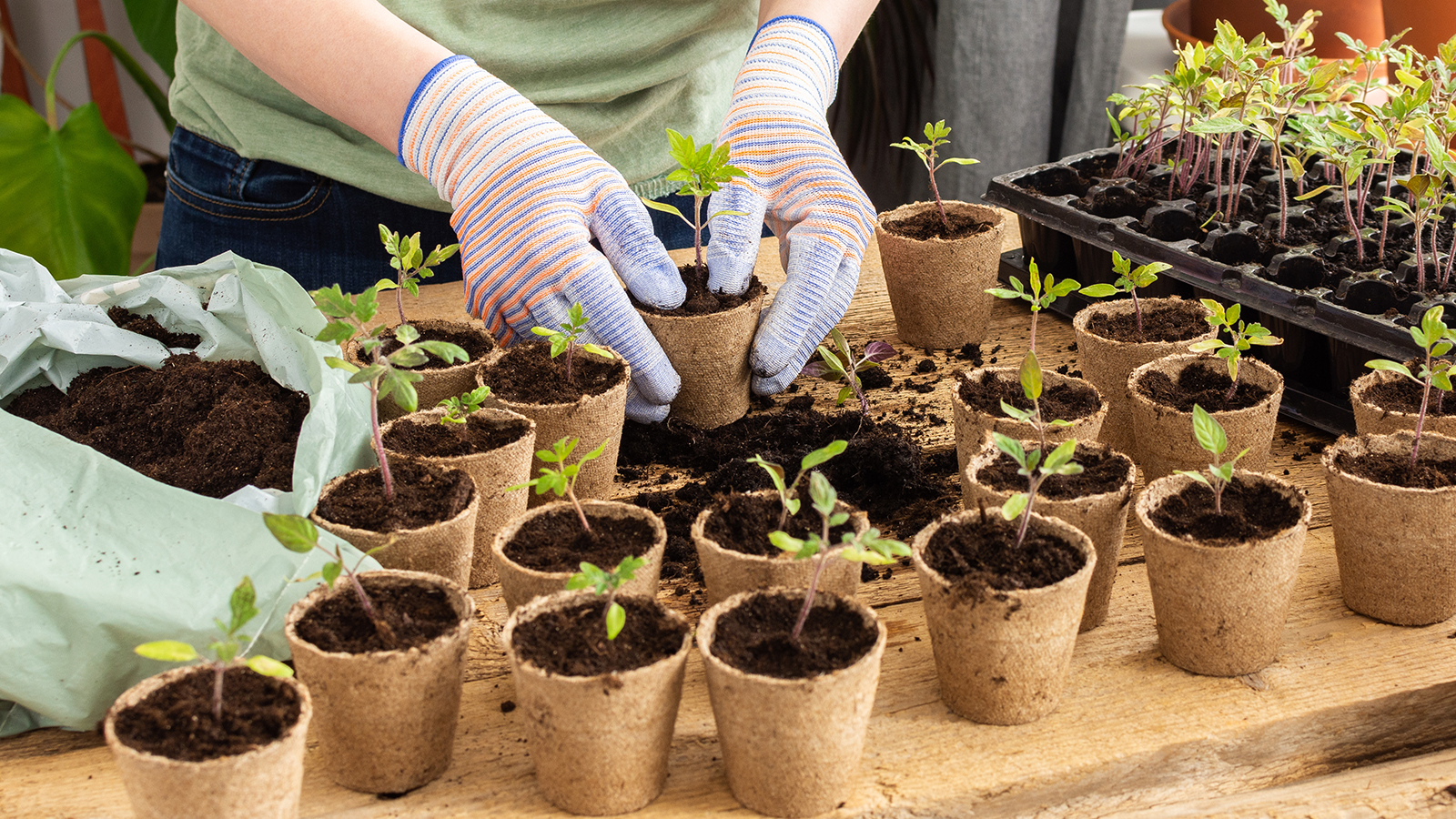
- Why Start Tomato Seeds Indoors?
- When to Start Tomato Seeds Indoors
- Choosing the Right Tomato Seeds
- How to Start Tomato Seeds Indoors – Step-by-Step
- 1. Soak the Seeds
- 2. Plant the Seeds
- 3. Warm Them Up
- 3. Keep Soil Moist
- 4. Move Seedlings into Bigger Pots
- 7. Give Them Lots of Light
- 8. Fertilize Seedlings
- 8. Harden Off & Plant
- Tomato Seedling Problems
- How Long Do Tomato Seeds Take to Grow?
Have you ever tried growing tomatoes from seed? There are a number of benefits to growing your own plants from scratch – plus, it’s just plain fun! Starting tomato seeds indoors is the best approach for most gardeners, as it enables you to control the growing conditions and get a head start on the growing season, for the longest possible harvest.
If you want to learn how to grow tomatoes like a pro, then you need to know a few things. You need to know how long tomato seeds take to germinate so you can start them at the right time for your climate; you need to know which types of tomatoes are best to grow for your individual circumstances; and you need to know how to take care of your precious seedlings so they will mature into strong, productive plants. Keep reading to learn all about how to grow tomatoes from seed.
Why Start Tomato Seeds Indoors?
The biggest benefit to learning how to start tomato seeds indoors is selection. When you go to the nursery or big box store to purchase a tomato plant, I’m sure you have noticed the lack of choice. After all, there are over 10,000 varieties of tomato – plenty of options, not just the half dozen available.
Next, growing tomato plants from seed is less likely to foster soil-borne diseases compared to store-bought plants. Seeds are also more cost-effective than buying plants.
Because you get to choose your tomato variety out of the thousands available, you get to pick the exact traits you want, whether it's colored tomatoes, the best-tasting tomatoes, disease-resistant tomatoes, varieties with a longer shelf life, or a particular size of fruit.
Lastly, starting your own tomato seeds can result in healthier plants. If you start your seeds inside early, the seedlings will have time to develop healthy root systems, which of course means healthier plants.

When to Start Tomato Seeds Indoors
The best time to start tomato plants from seeds is about six to eight weeks before you are ready to plant them in your garden. For areas that get frost, plan on planting out your tomato seedlings two to three weeks after your last frost date. This gives you a buffer, in case of an unexpected late frost.
Sign up for the Gardening Know How newsletter today and receive a free copy of our e-book "How to Grow Delicious Tomatoes".
This means the ideal time to start growing tomatoes from seed is four to six weeks before your last frost date.
Choosing the Right Tomato Seeds
One of your first selections is whether to plant determinate or indeterminate tomatoes. What’s the difference? Determinant tomatoes are compact plants that produce fruit all at one time – ideal for making sauces and canning. Indeterminate tomatoes produce fruit over the course of the growing season, but the plants get much larger than determinate varieties and need a trellis or other support.
Most heirloom tomatoes are indeterminate varieties of tomato. They come from seeds often passed down from generation to generation for at least 50 years. These seeds grow true to the parent plant, unlike hybrid tomatoes, which are made up of two or more parent plants selected for specific desired traits.
You also need to consider your climate when choosing what tomato to plant. This is best determined by looking at your USDA hardiness zone and last frost date. If you live in a cooler zone, your growing season is shorter, which means you will benefit from growing a crop of early tomatoes that will mature fast enough to harvest before the first fall freeze. However, those in warmer zones can also grow an early crop to beat the worst of the summer heat.
So how are you going to source these seeds? The Gardening Know How Shop offers a range of delicious and reliable tomato seed varieties, including heirloom and early types. To source seeds for free, try seed-saving groups on the internet or swap seeds with a friend or neighbor who can fill you in on how the crop did for them.
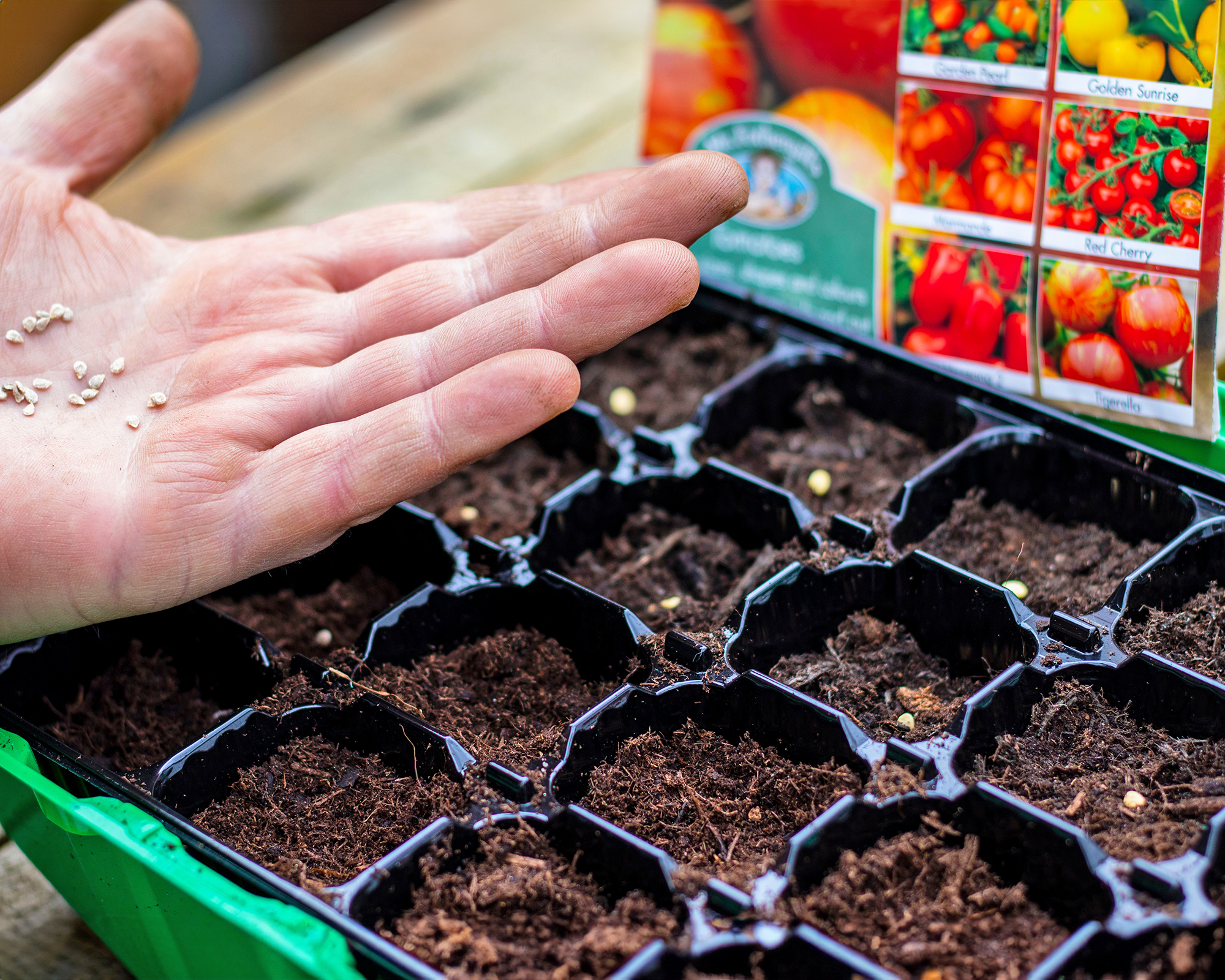
How to Start Tomato Seeds Indoors – Step-by-Step
When starting seeds inside, all you need is a shallow container no deeper than a couple of inches (2.5cm), some seed starting mix, and a very sunny window or grow lights.
Optional, but useful, are heating mats which can help speed up germination, and a humidity dome, which can aid in maintaining temperature and moisture.
Now that you have your supplies, you’ll want to know how to plant your tomato seeds.
1. Soak the Seeds
Drop your tomato seeds in a cup of lukewarm water the night before planting – though, 24 hours is best. Soaking seeds before planting is not strictly necessary, but it hydrates the dried seeds and speeds up germination. Drain the seeds from the water in a colander just before planting.
2. Plant the Seeds
Plant the seeds into a previously moistened, sterile seed-starting mix. Aim for a depth of three times the size of the seed. This will be about ⅛ to ¼ of an inch (3-6mm), depending on the tomato variety that you have chosen to grow.
If using individual containers, plant two tomato seeds per pot, or space them out in a seedling tray. You need to plant at least twice as many as you need as an insurance policy against seeds that do not germinate and failed seedlings.
3. Warm Them Up
After the tomato seeds have been planted, place the seedling containers in a warm area that’s around 70-80°F (21-27°C). This is where a warming mat covered with a towel can come in handy but it isn’t necessary as long as your room temperature is warm.
Many gardeners find that placing the planted tomato seed containers on top of the refrigerator or other appliance that generates heat from running works very well for germination.
Germination should occur in 5-10 days. Cooler temperatures will result in a longer germination time and warmer temperatures will make the tomato seeds germinate faster. Once the tomato seeds have germinated, you can take the tomato seedlings off the heat source, but they should still be kept somewhere warm.
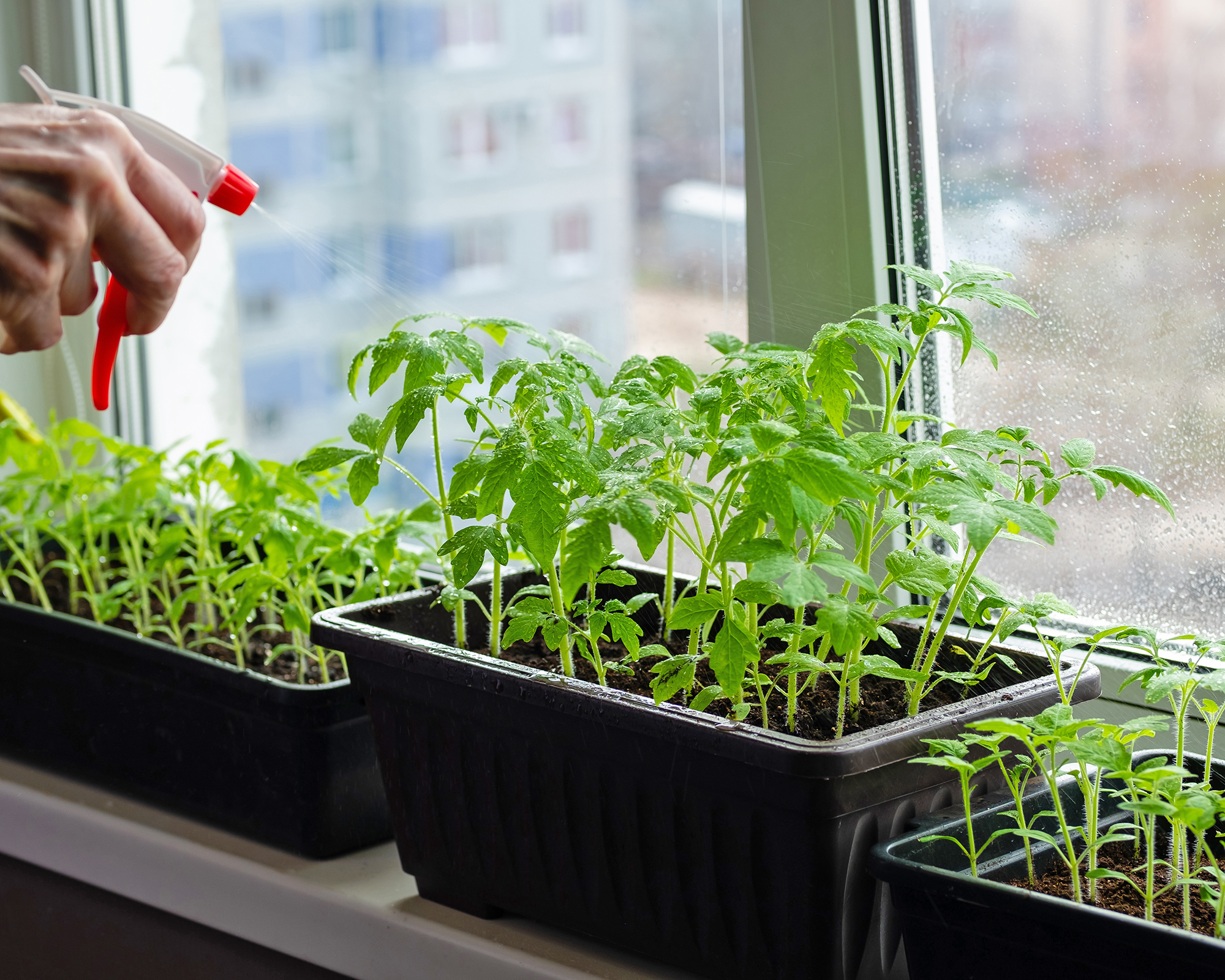
3. Keep Soil Moist
The growing medium should be consistently moist – but not soggy. To retain moisture, cover the container with plastic wrap or use a humidity dome. However, the cover should be removed once seedlings have emerged.
If the soil dries out, watering from below is best – place the trays or pots in a bowl filled with about an inch (2.5cm) of water. If bottom watering is not possible, misting the soil is a gentle way to water without harming the seedlings.
4. Move Seedlings into Bigger Pots
Once the first set of true leaves has appeared, remove the humidity dome or plastic lid and transplant the seedlings into 3-4 inch (8-10cm) pots with drainage holes. True leaves are the first leaves to develop that resemble those of the mature plant.
If you planted two seeds per pot in pots of this size, then you need to thin them out. Learning how to thin seedlings the right way is vital to ensure the strongest young plants have room to grow, and that you don't damage them in the process.
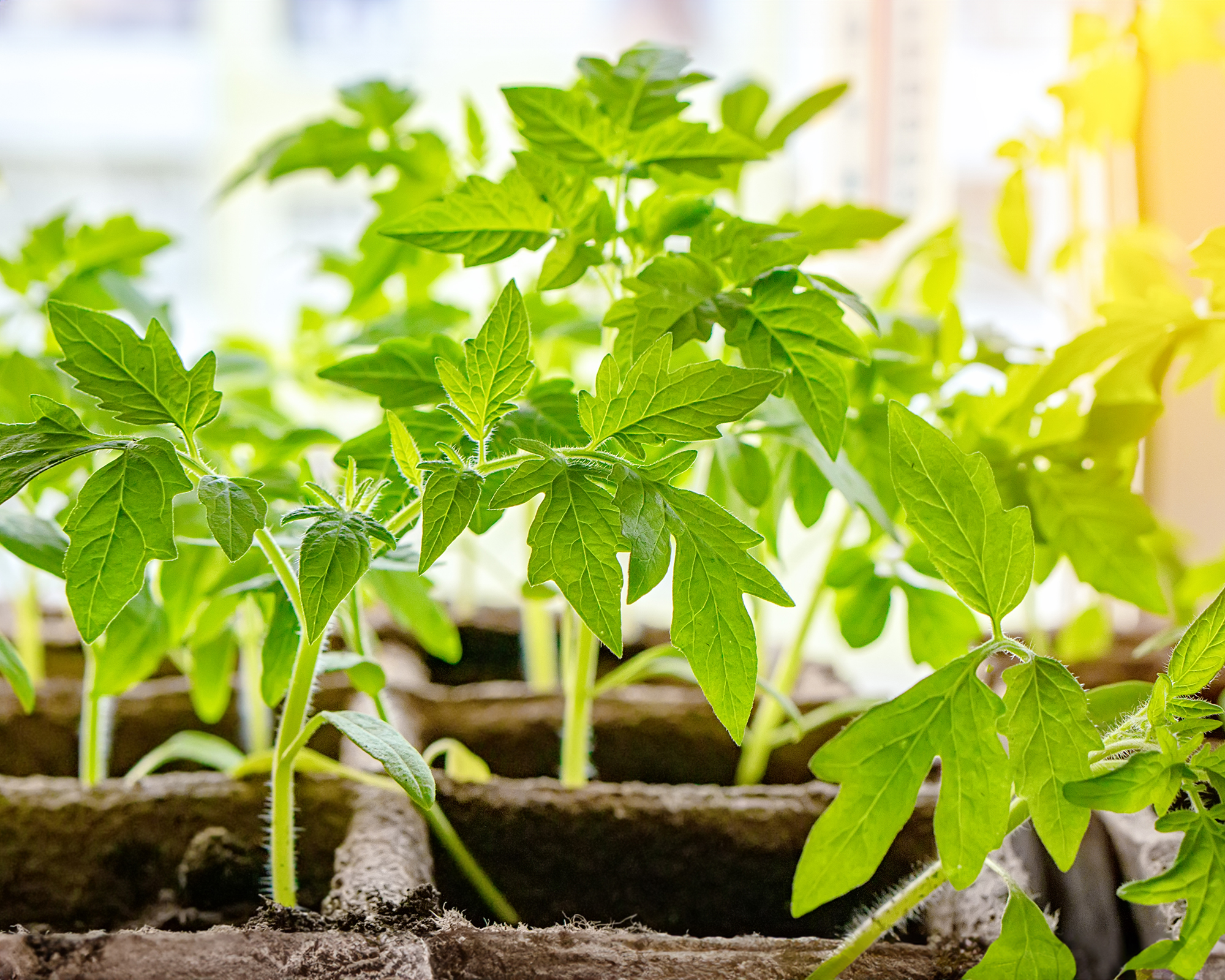
7. Give Them Lots of Light
How much light do seedlings need? About 12-16 hours per day. While a sunny southern window is good, it may not provide enough sunlight so you will likely have to supplement with a grow light. Position this a few inches (8cm) above the tomato seedlings.
If tomatoes don't get enough light, you will have weak, leggy seedlings. However, you may be able to salvage them by trench-planting tomatoes, which involves placing them somewhat horizontally into the planting hole. This encourages them to develop roots down the submerged stem, leading to stronger plants.
As your seedlings grow, continue to keep the soil moist and move the lights as needed.
8. Fertilize Seedlings
Once the young tomato plants have a set of true leaves then fertilizing seedlings will give them the boost they need to grow. Use a water-soluble tomato fertilizer diluted to quarter-strength.
If your tomato seedlings turn purple, they need some fertilizer and you should apply the quarter-strength fertilizer again.
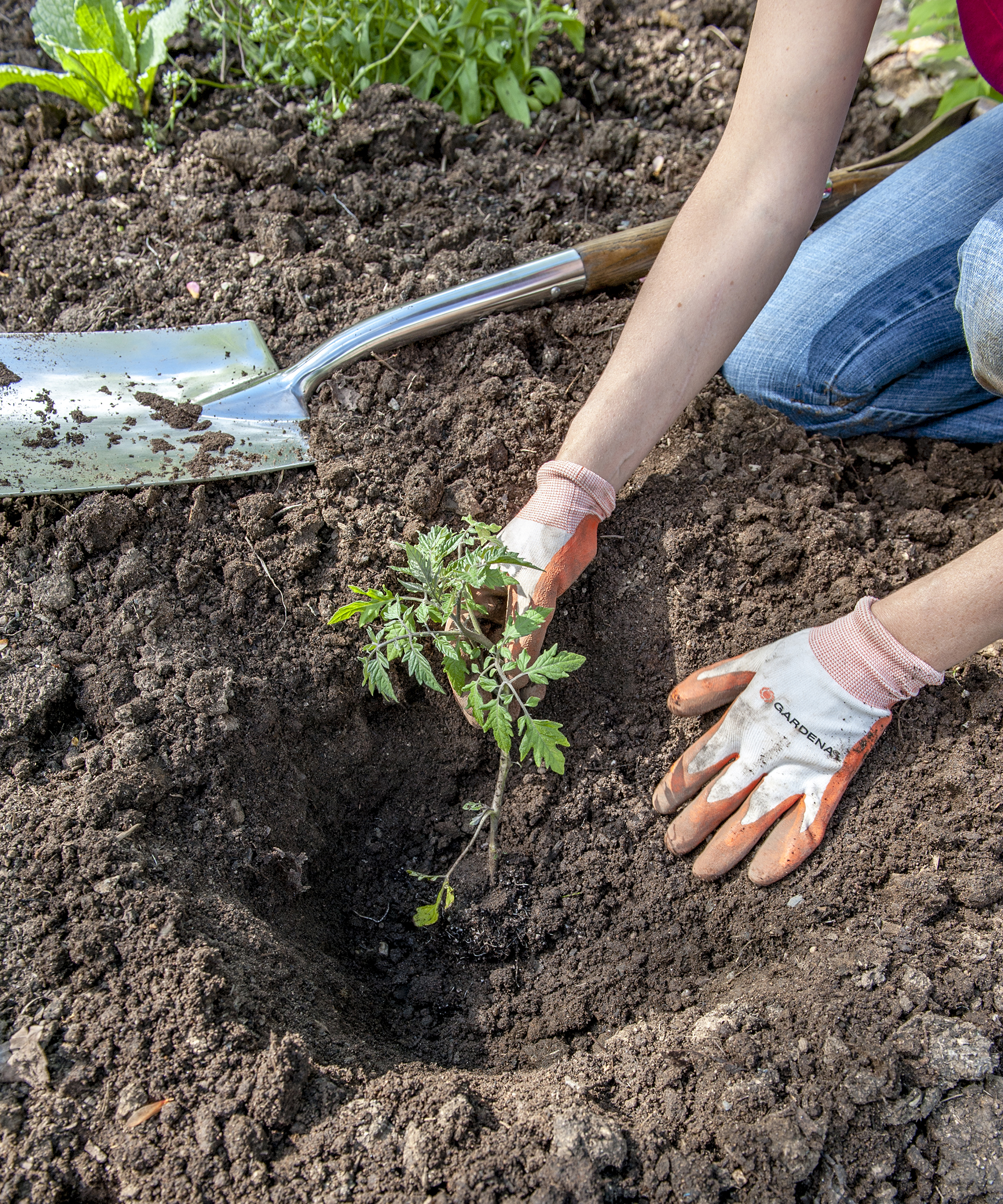
8. Harden Off & Plant
When the plants are 5 inches (13cm) in height at 6-8 weeks, harden off seedlings outside by gradually acclimating them to more light, gentle wind, and cooler temperatures over the course of 7-10 days. Bring the tomatoes inside at night if temperatures are still cool.
You can plant tomato plants in the ground, raised beds, or containers when they are at least six inches (15cm) tall. At this stage, they should have four to six true leaves. Plant tomatoes deep, right up to the first set of leaves, and they will develop new roots on the lower stem. Position plants in full sun, observing the appropriate tomato plant spacing.
Tomato Seedling Problems
Growing tomatoes from seed indoors isn't always plain sailing. Below are some common tomato seedling problems to look out for:
- Seeds not germinating is usually due to the seeds being too old, the soil being too wet, or the temperature being too low.
- Leggy seedlings, with tall weak stems, are caused by a lack of light.
- A stuck seed coat may be due to the seed not being planted deep enough for it to shed its coat before emerging, or the soil may be too dry. Mist it with water to soften it, then gently remove it.
- White fluffy fungus on the soil is caused by too much moisture and a lack of air movement. Reduce watering and increase airflow.
- Damping off is caused by the fungi Pythium or Rhizcronia, which are active in cool, wet, rich soil. If your tomato seedlings suddenly fall over, this is likely the cause.
- Tomato diseases show symptoms such as wilting, yellowing, spots, and legions on foliage and stems. Common culprits include early blight, fusarium wilt, botrytis, tomato mosaic, and curly top. In all cases, you must discard the seedlings and potting mix, and sterilize containers before starting again.
How Long Do Tomato Seeds Take to Grow?
Tomato seeds take anywhere from 5-10 days to germinate. After that, the seedlings are coddled for another 6-8 weeks plus a week or so to harden the plants off prior to transplant. Once the tomato seedlings are transplanted, it takes anywhere from 50-90 days until harvest – depending upon the cultivar.
Growing tomatoes from seed is a fun way to add some unusual variety to your garden. Now that you know how to start tomato seeds indoors, a whole new world of flavor is open to you.
You Might Also Like
- Discover the secret to growing perfect tomatoes with expert tips from a chef-turned-gardener.
- Mix your own homemade tomato fertilizer with these powerful natural recipes for a sublime crop.
- Check out self-watering rolling tomato planters in the Shop. They come complete with trellis and wheels for the ultimate, flexible solution for growing your own.
- Learn how to make a tomato hanging basket that's perfect for porches and patios.
- Sign up for the Gardening Know How email newsletter for unmissable ideas and inspiration to help transform your garden.
This article features products available from third party vendors on the Gardening Know How Shop.

Amy Grant has been gardening for 30 years and writing for 15. A professional chef and caterer, Amy's area of expertise is culinary gardening.
- Heather RhoadesFounder of Gardening Know How
- Melanie GriffithsEditor in Chief

